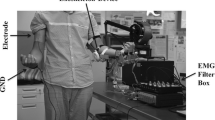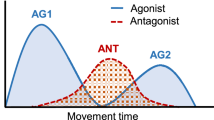Abstract.
In this work, we have studied a muscular control system under experimental conditions for analyzing the dynamic behavior of individual muscles and theoretical considerations for elucidating its control strategy. Movement of human limbs is achieved by joint torques and each torque is specified as the sum of torques generated by muscle forces. The behavior of individual muscles is controlled by the neural input which is estimated by means of an electromyogram (EMG). In this study, the EMGs for a flexor and an extensor are measured in elbow joint movements and the dynamic behavior of individual muscles is analyzed. As a result, it is verified that both a flexor and an extensor are activated throughout the entire movement and that the activation of muscles is controlled above a specific limit independent of the hand-held load. Subsequently, a system model for simulating elbow joint movements is developed which includes the muscle dynamic relationship between the neural input and the isometric force. The minimum limit of muscle activation that has been confirmed in experiments is provided as a constraint of the neural input and the criterion is defined by a derivative of the isometric force of individual muscles. The optimal trajectories formulated under these conditions are quantitatively compared with the experimentally observed trajectories, and the control strategy of a muscular control system is studied. Finally, a muscular control system in multi-joint arm movements is discussed with regard to the comparative analysis between observed and optimal trajectories.
Similar content being viewed by others
Author information
Authors and Affiliations
Additional information
Received: 7 April 1999 / Accepted in revised form: 27 July 1999
Rights and permissions
About this article
Cite this article
Kashima, T., Isurugi, Y. & Shima, M. Analysis of a muscular control system in human movements. Biol Cybern 82, 123–131 (2000). https://doi.org/10.1007/PL00007965
Issue Date:
DOI: https://doi.org/10.1007/PL00007965




